| Bougainvillea is a plant genus growing in tropical, subtropical and warm-temperate Central & South America. A few of its 18 species (and their hybrids) are cultivated abundantly for their profuse, intense, floral splendor. No matter where one travels in most tropical or subtropical cities, beautiful specimens of flamboyant color are enjoyed. Not obvious, however, are two things that I focus on in this article: some people in the cold north have grown the plants inside; and some people eat the flowers. |
| In both cases, the commonly cultivated species and hybrids are involved. They are thorny vines. In some regions, some cultivars can bloom for over half the year. Hummingbirds pollinate them. |
| The origin of the 1789 name Bougainvillea was explained in 1842 by W.J. Hooker: "In the year 1766, Bougainville touched [at Rio de Janeiro, Brazil], and his companion Commerson commemorated the name of the commander of the expedition in the beautiful Bougainvillea spectabilis, which he gathered in the hedges of the suburbs." Louis-Antoine de Bougainville lived from 1729 to 1814. |
Below are the two commonly cultivated species, and the commonly cultivated hybrid.
|
| Bougainvillea spectabilis Willd. |
| = B. brasiliensis Raeusch. |
| = B. bracteata Pers. |
| = B. peruviana Nees & Mart. 1823, non Bonpl. 1808 |
| = B. speciosa Schnizl. |
| = B. glabra auct., non Choisy |
| Bougainvillea spectabilis was the first species named, and cultivated --in California by 1829, in France by 1836; it was being sold at British nurseries by 1841. The British climate was too cool in summer to let the plants blossom. Finally, by 1844, in heated greenhouses, it did, and elicited such remarks from Englishmen as: |
| "Assuredly there is nothing in the whole vegetable kingdom more gorgeous than this." |
| "[so] ravishing in appearance, that [one] can only stand by it wrapt in mute wonder, and filled with gratitude that he has been permitted to look upon such a wondrous floral vision." |
| Cultivars started appearing by 1862. |
It is a powerful vine; has rough hairy shoots and leaves, purplish-mauve flowers, and stiff, formidable hooked spines.
|
| Bougainvillea glabra Choisy |
| (Paper Flower. Glory of the Garden. Lesser Bougainvillea) |
This second species was also cultivated in France first; it was in England by 1856. It may be less cold-tender (opinions vary) than Bougainvillea spectabilis and is surely not so large a vine. Its typical form has shiny leaves, bright mauve flowers, and stiff, straight spines. After its introduction to horticulture, it became the main species grown until it was superseded by its hybrids. Various cultivars exist.
|
| Bougainvillea x Buttiana Holtt. & Standl. |
| (B. glabra x B. peruviana) |
This hybrid originated in Colombia near 1910, and now plentiful cultivars exist. Often these hybrids are misidentified as B. spectabilis. They are similar to B. glabra, but their leaves are broader and not so shiny.
|
Other hybrids exist, such as Bougainvillea x specto-glabra hort. (B. spectabilis x B. glabra).
|
| As for attempting a Bougainvillea as a houseplant, or as a bonsai specimen, try to obtain a smaller growing cultivar (such as 'Raspberry Ice'), ideally a dwarf one intended for pot culture. That much is easy; getting it to bloom is more taxing. Allow it to become rootbound in its pot; use a clay pot; try to keep the pot outdoors in summer; more sun and warmth is ideal; do not over-water; the best soil is well-drained, and lean; use high-phosphorus fertilizer only. |
As for edibility, no books that I am aware of state Bougainvillea has been eaten. Related genera with edible species do exist, such as Mirabilis and Pisonia. Volume 11 (2008) of Subtropical Gardening magazine has a list of Edible Flowers by Arno King, that states: stewed Bougainvillea floral bracts are used to color drinks violet. Similarly, an entry dated April 6th 2011, on FlavorsoftheSun.blogspot.com: "Make limeade as you normally would, sweeten with desired sweetener, and add a cup or more of tea made from steeping purple bougainvillea blossoms in boiling water."
|
According to at least 2 websites / blogs, Bougainvillea floral bracts are eaten.
|
| March 9th 2010; AlleluiaPanis.wordpress.com: Bougainvillea, seaweed & mango salad served at Sa Balai restaurant. |
August 8th 2012 by Ericka Sanchez: "bougainvilleas are edible and blend deliciously with baby arugula and baby spinach."
|
| I have tasted floral bracts from several Bougainvillea clones, and found them acrid. I have eaten young tender leaves both raw and boiled, and found them undesirable. But since many clones exist, I shall keep trying, in hope to find one that I favor. |
Cautionary note: If you buy a Bougainvillea from a retailer, far more likely than not it had been sprayed with insecticides and fungicides. The eating of its leaves or flowers may harm you due to pesticide residue. To minimize risk, wait at least 2 and better yet 3 months after buying the plant, and only taste the new young leaves (or fresh flowers). Also be aware that the plant may be harmless to most people, yet cause an allergic reaction to you.
Back |
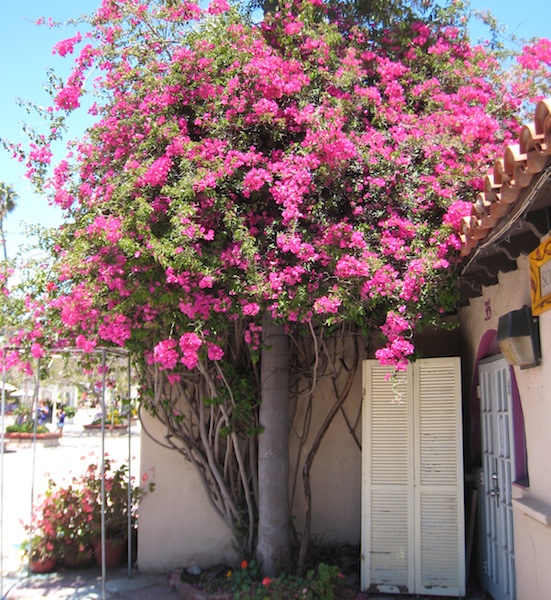
Bougainvillea; photo by ALJ
|
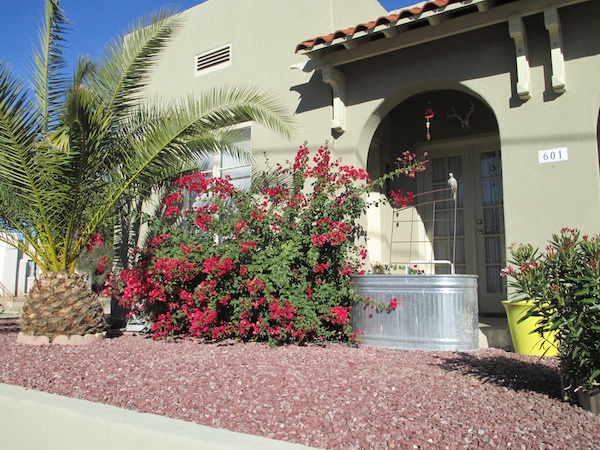
Bougainvillea; photo by ALJ
|
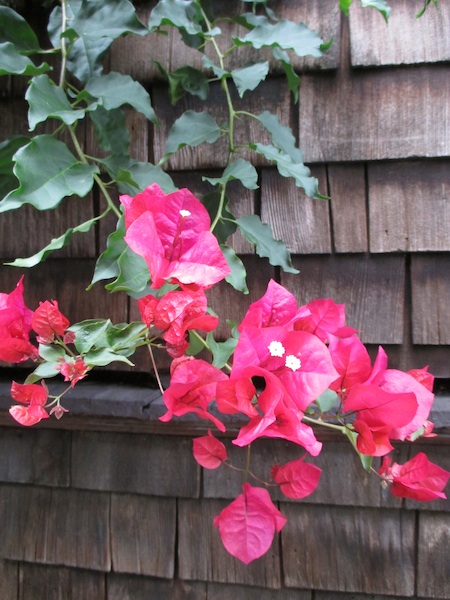
Bougainvillea; photo by ALJ
|
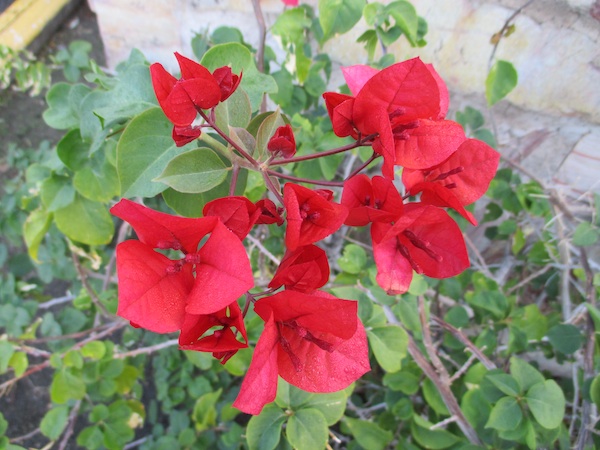
Bougainvillea; photo by ALJ
|
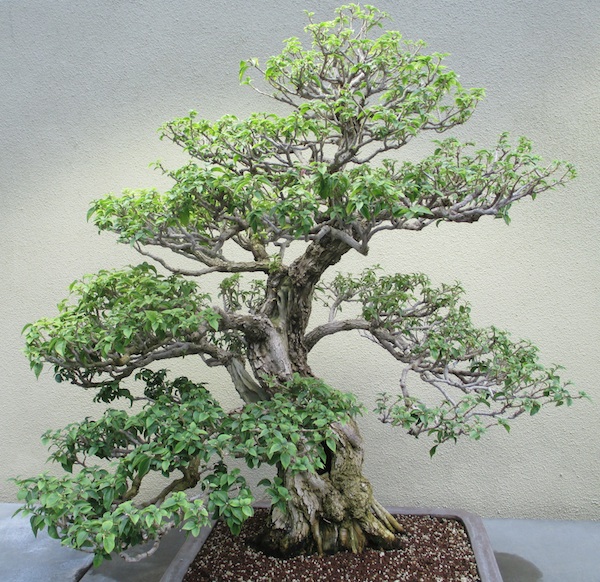
Bougainvillea bonsai; photo by ALJ
|

